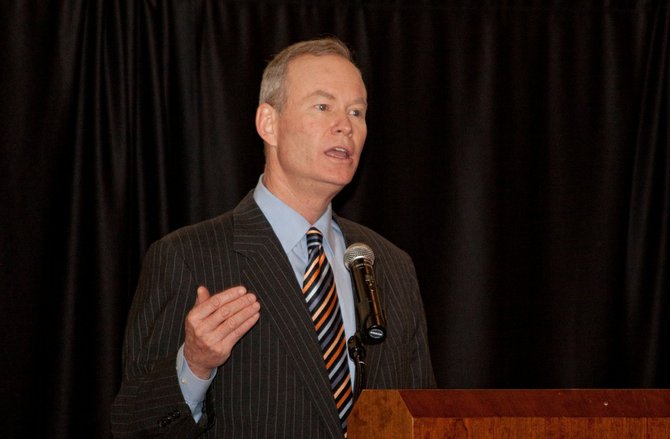Gov. Phil Bryant opened for keynote speaker and Oklahoma City mayor Mick Cornett at the Greater Jackson Chamber Partnership's Annual Meeting Wednesday. Photo by Courtesy Flickr/eschipul
It's not every day a governor opens for a headlining mayor.
That was the case Wednesday, though, when Gov. Phil Bryant gave an introductory speech before Oklahoma City, Okla. Mayor Mick Cornett gave some resounding words to the more-than 500 audience members at the Greater Jackson Chamber Partnership's annual meeting.
"You can pave these streets with gold, but until you fix the schools, nobody is moving downtown," Cornett said. Governing Magazine's 2010 Public Official of the Year was repeating something his city planner told him in 2001 about Oklahoma City, but the words pierced the crowd in a city with deteriorating roads, a small downtown population and a school district that nearly lost its accreditation during the summer of 2012.
In 1993, Oklahoma City's most talented and intelligent citizens were moving away from the city, Cornett said. It was a city with crumbling infrastructure, failing schools and an economy driven by an energy sector that had lost most of the luster it had in the mid-1970s. In the 1980s, 200 banks failed in the state of Oklahoma.
"We'd lost a generation of leadership," Cornett said.
Residents voted to enact a 1 percent sales tax to better their city. The $350 million the tax generated helped the city become a place where people wanted to live, instead of a place they wanted to flee, Cornett said.
The city rerouted water back into the riverbed that had been dry since the U.S. Army Corps of Engineers diverted the water after two floods in the 1920s. Then the city built entertainment and retail centers along the river, and invested in new and upgraded cultural, sports, recreation, entertainment and convention facilities. With the sales tax, the city built it all debt-free.
"People will vote to tax themselves for a better place to live," Cornett said.
With the new attractions, the downtown area went from being a ghost town after 5 p.m. to a bustling, vibrant epicenter. Still, few people chose to live in the area. That's when Cornett and his administration realized there were serious problems in the city's schools.
"We removed the lockers in one school, and the wall fell down," Cornett said. "The lockers were holding the walls up."
In 2001, the city voted on another temporary sales tax for schools. It passed by a 61-percent majority. From 2002 to its expiration in 2008, the tax generated $514 million, 70 percent of which went to the Oklahoma City Public School District and 30 percent to school districts in the surrounding suburbs.
When crews complete construction of the final facility this year, the money will have funded the building or renovation of 70 school buildings in the city and hundreds of other projects in the metro area.
Today, an average of 2,000 people move into the Oklahoma City metro area every month, Cornett said.
Cornett's message went over well with the GJCP crowd. Much of the GJCP's 10-year plan, Vision 2022, is based on priorities Cornett and his administration have for Oklahoma City. Similar to Oklahoma City's river, Vision 2022 wants to create a lakefront near downtown Jackson. The plan also focuses on pedestrian and public transportation, rebuilding infrastructure, building a vibrant arts-and-entertainment culture and improving the education system.
Gov. Bryant spoke about his plans for the legislative session. He said he wants to implement merit-based pay for teachers, require future teachers to make at least a 21 on the ACT, and provide full college scholarships for anyone who makes a 28 or higher and agrees to teach in Mississippi for at least five years.


